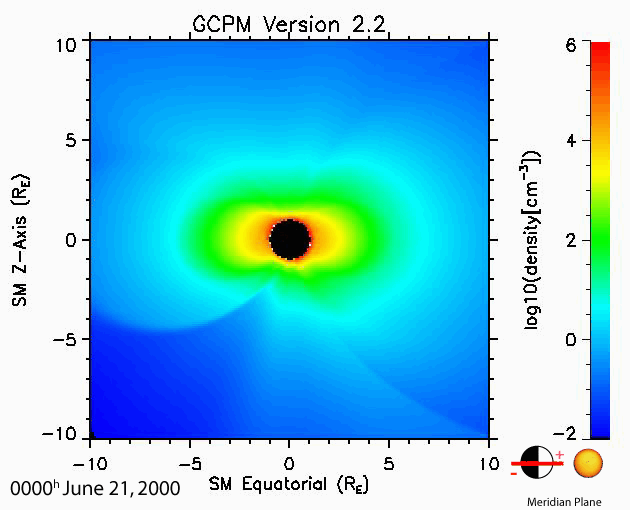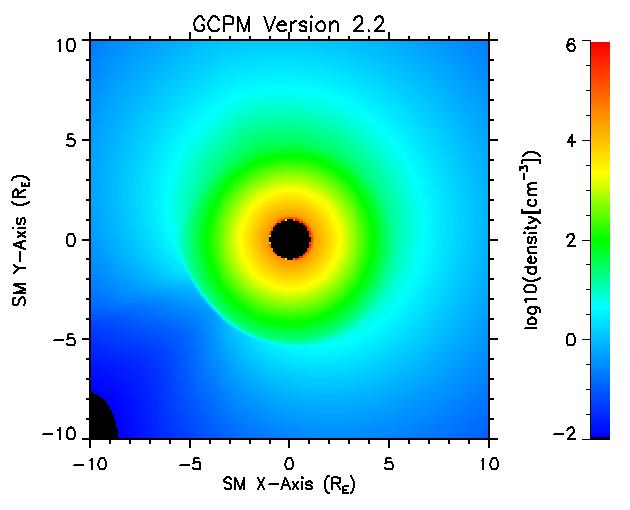Plasmaspheric Models

GCPM Version 2.2 Meridian Swing
To learn more about the images above, click the images.
"Below is at least a partial list of current plasmaspheric models. These specific models have been recognized in the academic community, but there are still many other plasmaspheric models. The list below is only a partial representation of the available plasmaspheric models. If I have missed one you want included, just let me know.
| Global Core Plasma Models20,21,22,23,24 | ||
| Version | Description | Files |
| 2.0 | Developed by D.L. Gallagher, P.D. Craven, and R.H. Comfort. This model includes the plasmasphere, plasmapause, magnetospheric trough, and an interface to the IRI model for ionospheric densities. It uses the Kp index with the IRI at 500-600 km altitude. | GCPM v2.0 IRI 95 X Form file Read Me File |
| 2.1 | Version 2.1 is like Version 2.0. It includes the polar caps as well as code corrections. | GCPM v2.1 IRI 95 X Form file Read Me File |
| 2.2 | Version 2.2 has even more code corrections, and makes use of the latest IRI model, IRI2007, which provides Sun Activity tables up to 2007. | GCPM v2.2 IRI 2007 (.tar) X Form file Read Me File |
| 2.3 | Version 2.3 includes the seasonal and solar cycle variations proposed by Carpenter and Anderson [1992] | GCPM v2.3 IRI2007 (.tar) X Form file Read Me File |
| 2.4 | Errors at low altitude/latitude and more are corrected in this version; if you are using an earlier version, don't. You want this one. | GCPM v2.4 IRI2007 (.tar) X Form file Read Me File |
| Models on Goddard Model Page | |||
| Title | Description | ||
| Akebono Model33 | Developed by I. Kutiev, K.-I. Oyama, S. Watanabe, and T. Abe. This model was developed from Akebono satellite measurements. It includes Te distributions at 1000-10,000 km altitudes and +/- 70 degree in geomagnetic latitude. | IMAGE Model30 | Developed by X. Huang, and B. Reinisch. This model was developed from RPI measurements on the IMAGE spacecraft. It gives density distribution along much of the magnetic field line. The model varies with L-value and latitude. | Global Plasma Ionosphere Density Model (GPID)53 | Developed by P.A. Webb and E.A. Essex. The GPID model uses a simplified theoretical approach to describe ion density and electron temperature in the plasmasphere along a magnetic flux tube. |
| Other Models | |||
| Title | Description | ||
| IZMIRAN10 | Developed by Chasovitin and Gulyaeva from observing whistlers and satellites. It presents global vertical analytical profiles of electron density smoothly fitted to IRI electron density profile at 1000 - 36,0000 km altitude. The model depends on solar activity and magnetic activity.1 Available through ftp at ftp://ftp.izmiran.rssi.ru/pub/izmiran/SPIM/ | ||
| SUPIM1 | Developed in part by Graham Bailey, the Sheffield University plasmasphere ionosphere model solves time-dependent equations of continuity, momentum, and energy balance along eccentric-dipole magnetic field lines for the densities, field-aligned fluxes and temperatures of the O+, H+, He+, N2+, O2+, and NO+ ions, and the electrons. | ||
| Carpenter and Anderson6 | An empirical model of equatorial electron density in the magnetosphere has been developed, covering the range 2.25 < L < 8. The principal data sources for the model were (1) electron density profiles deduced from sweep frequency receiver (SFR) radio measurements made along near-equatorial ISEE 1 satellite orbits and (2) previously published results from whistlers. The model describes, in piecewise fashion, the saturated plasmasphere, the region of steep plasmapause gradients, and the plasma trough. Additional terms account for (1) a solar cycle variation with a peak at solar maximum, (2) an annual variation with a December maximum, and (3) a semiannual variation with equinoctial maxima. | ||
| NeUoG-plas37,38 | NeUoG-plas is a complete and consistent ionosphere-plasmasphere model which provides continuity in all spatial first derivatives and therefore is usable directly for ray tracing applications. The model is based on the University of Graz electron density global ionospheric model (NeUoG). The field aligned extension of the ionospheric model into the plasmasphere is based on diffusive equilibrium. | O'Brian and Moldwin45 | CRRES observations are used to build empirical models of the plasmapause location as a function of Kp, AE, and Dst |
| Larsen et al36 | The plasmapause position is correlated with the IMF Bz, IMF clock angle and "phi" a merging proxy. Delay in the plasmapause response to Bz and clock anble is found to be 180 minutes, while delay to "phi" is found to be 240 minutes. Geomagnetic indices are avoided in the derived functional relation. | ||
| Belgian Inst. Space Aeronomy (BISA) | Considerable plasmaspheric modeling research has been performed at BISA. Of particular importance is the application of the plasma interchange instability mechanism to the plasmapause formation, including boundary structures such as shoulders, plumes, and notches. Details are available via the link provided here. | Center for Space Radiations | The formation of the plasmapause is illustrated in an animation based on the mechanism of Interchange using a time dependent magnetospheric electric field model. Relevant references and access to Professor Lemaire's simulations are also provided. | European Space Weather Portal39,40,41 | Plasmasphere models for density (V. Pierrard & K. Borremans, BISA), density and temperature (V. Pierrard & K. Borremans), and the plasmapause (V. Pierrard) are provided in addition to other magnetospheric models, data, and space weather forecasts. This site is comparable to the NASA Goddard content cited above. An account can be requested to obtain login access to the plasmasphere models. |
1. Information from the International Standards Organization (ISO) document on ionospheric and plasmaspheric thermal plasma (TS16457)
Web Links
NOAA's Space Weather Prediction Center - Today's Space Weather Updated Every 5-minutes
National Space Weather Program - The U.S. Government and Space Weather
Author: Dr. D.L. Gallagher dennis.gallagher @ nasa.gov
Responsible Official: Dr. David McKenzie
Last Updated: August 17, 2015
Responsible Official: Dr. David McKenzie
Last Updated: August 17, 2015

